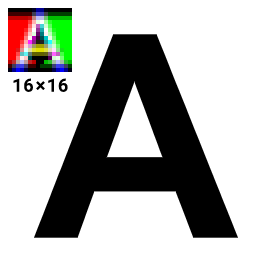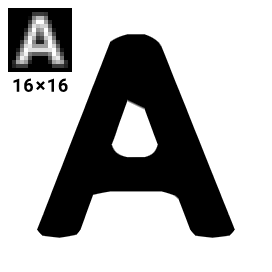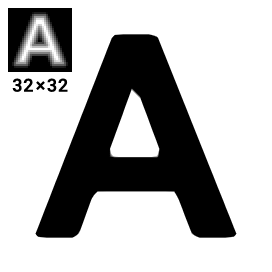215 lines
12 KiB
Markdown
215 lines
12 KiB
Markdown
# Multi-channel signed distance field generator
|
|
|
|
This is a utility for generating signed distance fields from vector shapes and font glyphs,
|
|
which serve as a texture representation that can be used in real-time graphics to efficiently reproduce said shapes.
|
|
Although it can also be used to generate conventional signed distance fields best known from
|
|
[this Valve paper](https://steamcdn-a.akamaihd.net/apps/valve/2007/SIGGRAPH2007_AlphaTestedMagnification.pdf)
|
|
and pseudo-distance fields, its primary purpose is to generate multi-channel distance fields,
|
|
using a method I have developed. Unlike monochrome distance fields, they have the ability
|
|
to reproduce sharp corners almost perfectly by utilizing all three color channels.
|
|
|
|
The following comparison demonstrates the improvement in image quality.
|
|
|
|

|
|

|
|

|
|
|
|
- To learn more about this method, you can read my [Master's thesis](https://github.com/Chlumsky/msdfgen/files/3050967/thesis.pdf).
|
|
- Check out my [MSDF-Atlas-Gen](https://github.com/Chlumsky/msdf-atlas-gen) if you want to generate entire glyph atlases for text rendering.
|
|
- See what's new in the [changelog](CHANGELOG.md).
|
|
|
|
## Getting started
|
|
|
|
The project can be used either as a library or as a console program. It is divided into two parts, **[core](core)**
|
|
and **[extensions](ext)**. The core module has no dependencies and only uses bare C++. It contains all
|
|
key data structures and algorithms, which can be accessed through the [msdfgen.h](msdfgen.h) header.
|
|
Extensions contain utilities for loading fonts and SVG files, as well as saving PNG images.
|
|
Those are exposed by the [msdfgen-ext.h](msdfgen-ext.h) header. This module uses
|
|
[FreeType](https://freetype.org/),
|
|
[TinyXML2](https://www.grinninglizard.com/tinyxml2/),
|
|
[libpng](http://www.libpng.org/pub/png/libpng.html),
|
|
and (optionally) [Skia](https://skia.org/).
|
|
|
|
Additionally, there is the [main.cpp](main.cpp), which wraps the functionality into
|
|
a comprehensive standalone console program. To start using the program immediately,
|
|
there is a Windows binary available for download in the ["Releases" section](https://github.com/Chlumsky/msdfgen/releases).
|
|
To use the project as a library, you may install it via the [vcpkg](https://vcpkg.io) package manager as
|
|
```
|
|
vcpkg install msdfgen
|
|
```
|
|
Or, to build the project from source, you may use the included [CMake script](CMakeLists.txt).
|
|
In its default configuration, it requires [vcpkg](https://vcpkg.io) as the provider for third-party library dependencies.
|
|
If you set the environment variable `VCPKG_ROOT` to the vcpkg directory,
|
|
the CMake configuration will take care of fetching all required packages from vcpkg.
|
|
|
|
## Console commands
|
|
|
|
The standalone program is executed as
|
|
```
|
|
msdfgen.exe <mode> <input> <options>
|
|
```
|
|
where only the input specification is required.
|
|
|
|
Mode can be one of:
|
|
- **sdf** – generates a conventional monochrome (true) signed distance field.
|
|
- **psdf** – generates a monochrome signed pseudo-distance field.
|
|
- **msdf** (default) – generates a multi-channel signed distance field using my new method.
|
|
- **mtsdf** – generates a combined multi-channel and true signed distance field in the alpha channel.
|
|
|
|
The input can be specified as one of:
|
|
- **-font \<filename.ttf\> \<character code\>** – to load a glyph from a font file.
|
|
Character code can be expressed as either a decimal (63) or hexadecimal (0x3F) Unicode value, or an ASCII character
|
|
in single quotes ('?').
|
|
- **-svg \<filename.svg\>** – to load an SVG file. Note that only the last vector path in the file will be used.
|
|
- **-shapedesc \<filename.txt\>**, -defineshape \<definition\>, -stdin – to load a text description of the shape
|
|
from either a file, the next argument, or the standard input, respectively. Its syntax is documented further down.
|
|
|
|
The complete list of available options can be printed with **-help**.
|
|
Some of the important ones are:
|
|
- **-o \<filename\>** – specifies the output file name. The desired format will be deduced from the extension
|
|
(png, bmp, tif, txt, bin). Otherwise, use -format.
|
|
- **-size \<width\> \<height\>** – specifies the dimensions of the output distance field (in pixels).
|
|
- **-range \<range\>**, **-pxrange \<range\>** – specifies the width of the range around the shape
|
|
between the minimum and maximum representable signed distance in shape units or distance field pixels, respectivelly.
|
|
- **-scale \<scale\>** – sets the scale used to convert shape units to distance field pixels.
|
|
- **-translate \<x\> \<y\>** – sets the translation of the shape in shape units. Otherwise the origin (0, 0)
|
|
lies in the bottom left corner.
|
|
- **-autoframe** – automatically frames the shape to fit the distance field. If the output must be precisely aligned,
|
|
you should manually position it using -translate and -scale instead.
|
|
- **-angle \<angle\>** – specifies the maximum angle to be considered a corner.
|
|
Can be expressed in radians (3.0) or degrees with D at the end (171.9D).
|
|
- **-testrender \<filename.png\> \<width\> \<height\>** - tests the generated distance field by using it to render an image
|
|
of the original shape into a PNG file with the specified dimensions. Alternatively, -testrendermulti renders
|
|
an image without combining the color channels, and may give you an insight in how the multi-channel distance field works.
|
|
- **-exportshape \<filename.txt\>** - saves the text description of the shape with edge coloring to the specified file.
|
|
This can be later edited and used as input through -shapedesc.
|
|
- **-printmetrics** – prints some useful information about the shape's layout.
|
|
|
|
For example,
|
|
```
|
|
msdfgen.exe msdf -font C:\Windows\Fonts\arialbd.ttf 'M' -o msdf.png -size 32 32 -pxrange 4 -autoframe -testrender render.png 1024 1024
|
|
```
|
|
|
|
will take the glyph capital M from the Arial Bold typeface, generate a 32×32 multi-channel distance field
|
|
with a 4 pixels wide distance range, store it into msdf.png, and create a test render of the glyph as render.png.
|
|
|
|
**Note:** Do not use `-autoframe` to generate character maps! It is intended as a quick preview only.
|
|
|
|
## Library API
|
|
|
|
If you choose to use this utility inside your own program, there are a few simple steps you need to perform
|
|
in order to generate a distance field. Please note that all classes and functions are in the `msdfgen` namespace.
|
|
|
|
- Acquire a `Shape` object. You can either load it via `loadGlyph` or `loadSvgShape`, or construct it manually.
|
|
It consists of closed contours, which in turn consist of edges. An edge is represented by a `LinearEdge`, `QuadraticEdge`,
|
|
or `CubicEdge`. You can construct them from two endpoints and 0 to 2 Bézier control points.
|
|
- Normalize the shape using its `normalize` method and assign colors to edges if you need a multi-channel SDF.
|
|
This can be performed automatically using the `edgeColoringSimple` heuristic, or manually by setting each edge's
|
|
`color` member. Keep in mind that at least two color channels must be turned on in each edge, and iff two edges meet
|
|
at a sharp corner, they must only have one channel in common.
|
|
- Call `generateSDF`, `generatePseudoSDF`, or `generateMSDF` to generate a distance field into a floating point
|
|
`Bitmap` object. This can then be worked with further or saved to a file using `saveBmp`, `savePng`, or `saveTiff`.
|
|
- You may also render an image from the distance field using `renderSDF`. Consider calling `simulate8bit`
|
|
on the distance field beforehand to simulate the standard 8 bits/channel image format.
|
|
|
|
Example:
|
|
```c++
|
|
#include "msdfgen.h"
|
|
#include "msdfgen-ext.h"
|
|
|
|
using namespace msdfgen;
|
|
|
|
int main() {
|
|
FreetypeHandle *ft = initializeFreetype();
|
|
if (ft) {
|
|
FontHandle *font = loadFont(ft, "C:\\Windows\\Fonts\\arialbd.ttf");
|
|
if (font) {
|
|
Shape shape;
|
|
if (loadGlyph(shape, font, 'A')) {
|
|
shape.normalize();
|
|
// max. angle
|
|
edgeColoringSimple(shape, 3.0);
|
|
// image width, height
|
|
Bitmap<float, 3> msdf(32, 32);
|
|
// range, scale, translation
|
|
generateMSDF(msdf, shape, 4.0, 1.0, Vector2(4.0, 4.0));
|
|
savePng(msdf, "output.png");
|
|
}
|
|
destroyFont(font);
|
|
}
|
|
deinitializeFreetype(ft);
|
|
}
|
|
return 0;
|
|
}
|
|
|
|
```
|
|
|
|
## Using a multi-channel distance field
|
|
|
|
Using a multi-channel distance field generated by this program is similarly simple to how a monochrome distance field is used.
|
|
The only additional operation is computing the **median** of the three channels inside the fragment shader,
|
|
right after sampling the distance field. This signed distance value can then be used the same way as usual.
|
|
|
|
The following is an example GLSL fragment shader with anti-aliasing:
|
|
|
|
```glsl
|
|
in vec2 texCoord;
|
|
out vec4 color;
|
|
uniform sampler2D msdf;
|
|
uniform vec4 bgColor;
|
|
uniform vec4 fgColor;
|
|
|
|
float median(float r, float g, float b) {
|
|
return max(min(r, g), min(max(r, g), b));
|
|
}
|
|
|
|
void main() {
|
|
vec3 msd = texture(msdf, texCoord).rgb;
|
|
float sd = median(msd.r, msd.g, msd.b);
|
|
float screenPxDistance = screenPxRange()*(sd - 0.5);
|
|
float opacity = clamp(screenPxDistance + 0.5, 0.0, 1.0);
|
|
color = mix(bgColor, fgColor, opacity);
|
|
}
|
|
```
|
|
|
|
Here, `screenPxRange()` represents the distance field range in output screen pixels. For example, if the pixel range was set to 2
|
|
when generating a 32x32 distance field, and it is used to draw a quad that is 72x72 pixels on the screen,
|
|
it should return 4.5 (because 72/32 * 2 = 4.5).
|
|
**For 2D rendering, this can generally be replaced by a precomputed uniform value.**
|
|
|
|
For rendering in a **3D perspective only**, where the texture scale varies across the screen,
|
|
you may want to implement this function with fragment derivatives in the following way.
|
|
I would suggest precomputing `unitRange` as a uniform variable instead of `pxRange` for better performance.
|
|
|
|
```glsl
|
|
uniform float pxRange; // set to distance field's pixel range
|
|
|
|
float screenPxRange() {
|
|
vec2 unitRange = vec2(pxRange)/vec2(textureSize(msdf, 0));
|
|
vec2 screenTexSize = vec2(1.0)/fwidth(texCoord);
|
|
return max(0.5*dot(unitRange, screenTexSize), 1.0);
|
|
}
|
|
```
|
|
|
|
`screenPxRange()` must never be lower than 1. If it is lower than 2, there is a high probability that the anti-aliasing will fail
|
|
and you may want to re-generate your distance field with a wider range.
|
|
|
|
## Shape description syntax
|
|
|
|
The text shape description has the following syntax.
|
|
- Each closed contour is enclosed by braces: `{ <contour 1> } { <contour 2> }`
|
|
- Each point (and control point) is written as two real numbers separated by a comma.
|
|
- Points in a contour are separated with semicolons.
|
|
- The last point of each contour must be equal to the first, or the symbol `#` can be used, which represents the first point.
|
|
- There can be an edge segment specification between any two points, also separated by semicolons.
|
|
This can include the edge's color (`c`, `m`, `y` or `w`) and/or one or two Bézier curve control points inside parentheses.
|
|
|
|
For example,
|
|
```
|
|
{ -1, -1; m; -1, +1; y; +1, +1; m; +1, -1; y; # }
|
|
```
|
|
would represent a square with magenta and yellow edges,
|
|
```
|
|
{ 0, 1; (+1.6, -0.8; -1.6, -0.8); # }
|
|
```
|
|
is a teardrop shape formed by a single cubic Bézier curve.
|